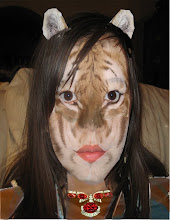- Donate a dollar to your local animal shelter
- Adopt a pet from a shelter or rescue a street animal
- Help your neighbors pet-sit
- Feed the local strays
Thursday, December 16, 2010
Natural World: Reach Out
Bengal Tigers

Bengal tigers (panthera tigris tigris) are one of the six non-extinct subspecies of tiger. It is the least endangered subspecies, though it is still critically endangered. The Bengal tiger is most commonly found in southern India, and lives in tropical dry forest (where Asiatic Lions can be found) or tropical rain forests. They are the second largest of the tigers, seconding only to the Amur tiger.
Bengal tigers have two main genetic mutations. One is the wide-band gene, which causes the "Golden Tabby" or "Strawberry" color variat
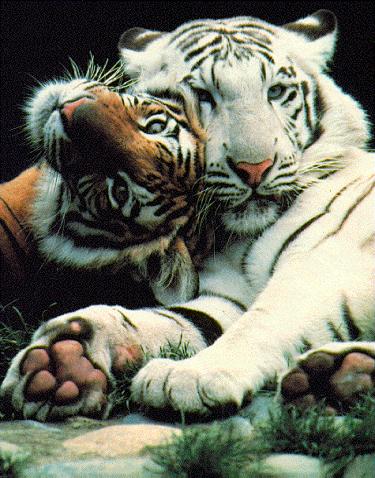 ion. The other is a gene which causes a white tiger. This can also occur with the Amur tiger, though it is considerably more rare. Despite common misconception, white tiger is a tiger that is white with black stripes, not an all white tiger.
ion. The other is a gene which causes a white tiger. This can also occur with the Amur tiger, though it is considerably more rare. Despite common misconception, white tiger is a tiger that is white with black stripes, not an all white tiger.
Bengal tigers have 2-4 cubs in a litter, and stay with them for two years. The mother raises the cubs. They get taught how to hunt, how to fight, and how to survive. After those two years, the cubs leave the den, and rarely, if ever see each other again.
Despite their mostly solitary lifestyle, tigers sometimes form large groups known as streaks. The tigers help raise each other's cubs, care for each other when hurt, and though they hunt alone or in pairs, they hunt for the group.
So take a look at the local cat, then look at their majestic big cat cousin, the tiger. What do you see?
FUN FACTS:
- Did you know that the scientific name of the Bengal tiger was once Panthera Tigris Bengalensis?I didn't even know that, and I'm a Bengal Tiger! I found this fact when I was searching the web for more infromation, and I found this on wikipedia.org
- Bengal tigers are sometimes called Indian Tigers
Monday, November 15, 2010
From Magma to Mineral
I know I promised a post about Bengal Tigers, and don't worry, it'll be up soon. But in my spare time I wrote a science fiction story about the rock cycle called From Magma to Mineral. I wanted to share it with you!
From
Magma
to
Mineral
A sci-fi story explaining the rock cycle
My name is Akane. Brilliant red. I started out beneath the earth’s surface as magma. For years I stayed there; hidden from the eyes of anyone. Then I began to get pushed up. It was cooler here. I began to cool down. I felt my liquid body harden and trap me. I was an ingneous rock.
I kept on getting pushed up until I finally broke the surface of the earth. I stayed there for a while before waves began to bash against me. It hurt. A lot. I was in pieces, I was sediment. It was horrible- being broken up like that. Then something began to seep down between the peices of me. Whatever it was fused me together again. Differently, yes, but together all the same.
I continued on as siltstone. Then the plates shifted. I fell down, down down. I was warped and changed and I was heated to my limit. I liquified. I stayed as magma for a long while. I bubbled up again and crystallized as granite. I got heated again and warped once more, though I didn’t liquify this time. I was metamorphic rock.
Water bashed against me and I broke apart again. oh, HOW I HATED THIS PAIN! But Iwas fused again. I was happy to be whole. Yet it happened again. I was broken. Then I was pushed downward and I melted. Today I am still magma.
I hope you liked the story!
Monday, July 5, 2010
HAPPY "NEW" YEAR!

Hi! This is a very, very hyper Tigrette here (I think I'm sugar high or something). I know its not new years and I did promise to do a Bengal Tigers post, and being a tiger, whether you say it in Spanish, Japanese or English, I am still a tiger and as one i am true to my word. So don't worry about that, a Bengal Tiger post is on the way. But, this is priority. Natural World has been on the web for one year as of today! So, I'd like to acknowledge a few people! TO MY SUBSCRIBERS (FROM ALL YEAR, EVEN IF THEY'VE UNSUBSCRIBED) THANK YOU: CAMDOOZER! AMELIA HULME! MADDIE RICHARDSON GRAHAM! SAM BUNSON! ONENOTENOUGH! MARCUSERE! VALENE HULME! M&M! ADMIRAL! TO MY REVEIWERS!
THANK YOU:
JAYNE!
KRISMCMILLEN07星美 ! AMELIA HULME!
ADMIRAL!
CAMDOOZER!
子ChristiLavigne11善! ELEVEN!
LOACH!
Y!
VIVIDLY!
JT!
경미! DISHA!
MADDIE!
So thanks again Everyone! My Profile picture may change soon because my appearance has changed sense I started this blog! -Tigrette Starlight Rose PS. Excuse my lame Photoshop skills. Being a tiger, it's hard to use a computer. (even though i have a humanoid appearence, i'm stuck in my tiger form for the next few days, which sucks big time)
Wednesday, June 23, 2010
Wolves
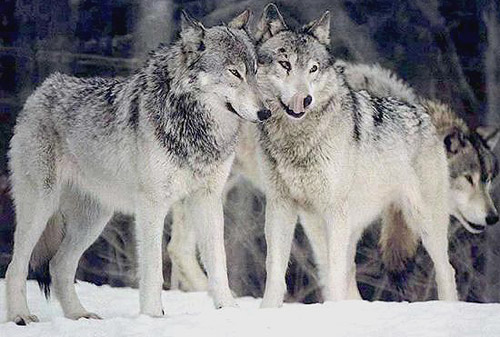
The Grey Wolf (Canis Lupus), also known as just; the wolf, are dominant predators and the largest of canines. In size, wolves resemble a German Shepard, or a Husky, though they are larger still. There are many subspecies of grey wolf, though the exact number is up for debate. At one point, wolves lived in most of the northern regions of Europe, Asia, and North America, but that territory has become increasingly smaller for various reasons.
Wolves are very tough animals, as the inmabit many biomes. There paws are large, and have a slight webbing between each clawed toe, to enable the predator to move more agilely than the prey they hunt. Wolves also have two layers of their pelt, though the undercoat is shed in the hotter months. The undercoat is an insulator, that is water resistant, and the overcoat keeps dirt and wind from the animals body. Wolves pelts have a wide range of colors; red-browns, browns, whites, greys, blacks, and grey-browns. Usually there is a mix of two or more colors (greys/grey browns with white is relatively common), though a one-color pelt is not uncommon. Single-color furs are usually all white or all black. The fur is lighter on the belly for two-tones or multi-tones.
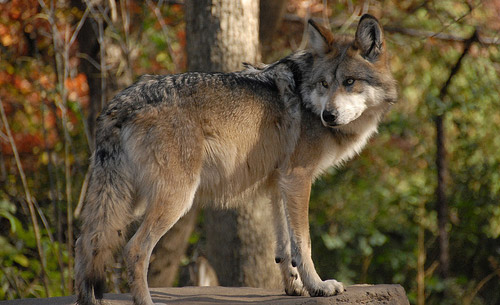 At birth, wolf pups are darker in color, and have baby-blue eyes, which will eventually change to a color ranging from yellowish gold to orange. Wolves have distinct muzzles, which are long and powerful, which is different from most other canines.
At birth, wolf pups are darker in color, and have baby-blue eyes, which will eventually change to a color ranging from yellowish gold to orange. Wolves have distinct muzzles, which are long and powerful, which is different from most other canines.Wolves often live in packs led by an Alpha, though loners are not nonexistent. Lone wolves commonly were driven from there pack by the alpha, usually after some sort of wrongdoing. Packs usually consist of an alpha, there mate, their pups, the hunters, and their pups. Wolves are very territorial, though loners are occasionally accepted in to a pack. Wolves are carnivores, feeding mainly on deer, moose, elk and other large prey.
Wolves do not bark. They snarl, growl and howl for various reasons, though despite popular belief that wolves "howl at the moon", is urban myth. Wolves howls can be heard more clearly at night due to the fact that there is less sound at night. Howling is a means of long distance communication.
Wolves and dogs are close enough in gene code to produce fertile and healthy offspring, and though uncommon, matings between wild wolves and domesticated dogs has occurred. Wolfdogs are less open to genetic diseases than most dogs. The German Shepard species is actually the result of breeding a wolf and a dog, then a wolfdog and a dog, and so on. Coywolves (a cross between a coyote and a wolf), are possible. The smaller
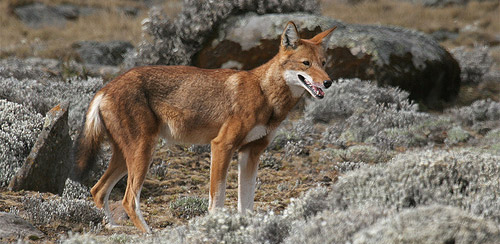 Red Wolf, or Timber Wolf (Canis rufus), is the result of the mating of a coyote and a wolf, then a coywolf and a wolf, and so on. By many the Timber Wolf is concidered a subspecies, and scientifically that is currently up for debate.
Red Wolf, or Timber Wolf (Canis rufus), is the result of the mating of a coyote and a wolf, then a coywolf and a wolf, and so on. By many the Timber Wolf is concidered a subspecies, and scientifically that is currently up for debate.Wolf Subspecies include:
- The Artic Wolf, (canis lupus arctos)
- The Tundra Wolf or Eurasian Artic , (canis lupus albus)
- The Arabian Wolf, (canis lupus arabs)
- The Mexican Wolf, (canis lupus baileyi)
- The Russian Wolf, (canis lupus communis)
- The Italian Wolf, (canis lupus italicus)
- The Egyptian Wolf, (canis lupus lupaster)
- The Eurasian Wolf, (canis lupus lupus)
- The Eastern Wolf, (canis lupus lycoan)
- The Great Plains Wolf, (canis lupus nubilus)
- The Northwestern Wolf, (canis lupus occidentalis)
- The Indian Wolf, (canis lupus pallipes)
- The Iberian Wolf (Canis lupus signatus)
- The Ethiopian Wolf (Canis simensis)
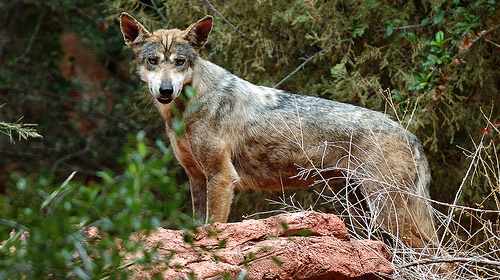
This post is dedicated to my "summer sister" Timbra Wolf
A big thanks to:
http://wikipedia.org/wiki/wolf
AND
http://www.caninest.com/types-of-wolf/
Saturday, May 15, 2010
NOTE!
Tuesday, May 11, 2010
Island Mountain Gacier
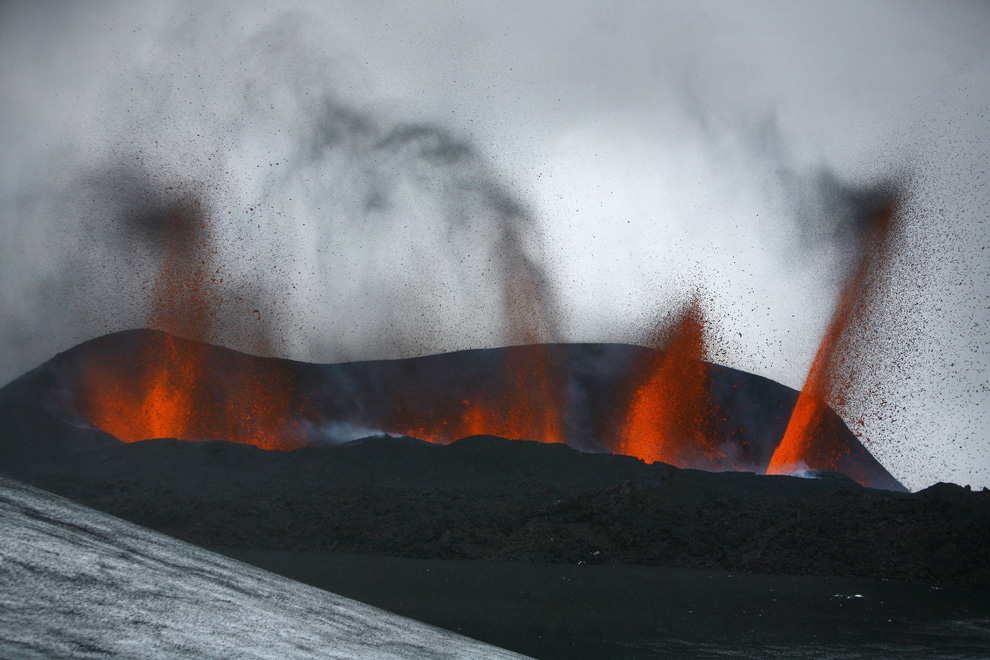
So much has changed in Iceland sense April 12th. What once seemed clean and green is now dark and dingy. Iceland once raked high on the EPI list, but now, it is not looking so good for the country.
This is an incorrect accusation. The true outcome is that the country is even greener. The stopped airline flights saved more carbon than the volcano could spew.
In short term, results could be disastrous. but that will not last long, a few months at the most. In addition, the gasses will not ill-effect out efforts against global warming, actually, the ash and sulfur dioxide may help cool our Earth.
In reality, the Island Mountain Glacier's eruption is not as large as others, and in the end, this will not hurt us, but help us
Co-written by:
-Tigrette Starlight Rose, Sibra Lynx and Amur LeoPard
Thanks to:
-Jr. Schoolastic
-C-The-Happy
-Tai and Tai again

